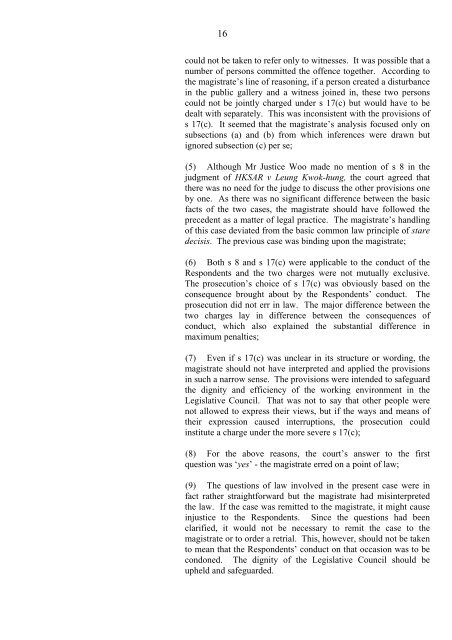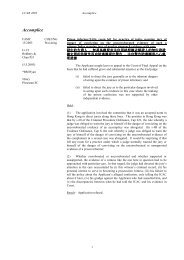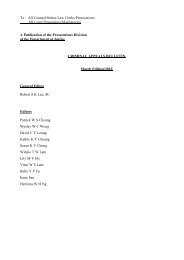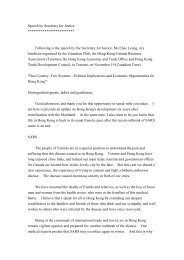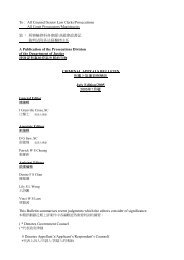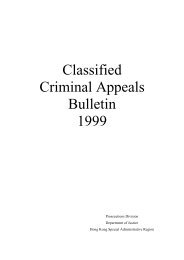刑事檢控科各律師/高級律 - Department of Justice
刑事檢控科各律師/高級律 - Department of Justice
刑事檢控科各律師/高級律 - Department of Justice
You also want an ePaper? Increase the reach of your titles
YUMPU automatically turns print PDFs into web optimized ePapers that Google loves.
16<br />
could not be taken to refer only to witnesses. It was possible that a<br />
number <strong>of</strong> persons committed the <strong>of</strong>fence together. According to<br />
the magistrate’s line <strong>of</strong> reasoning, if a person created a disturbance<br />
in the public gallery and a witness joined in, these two persons<br />
could not be jointly charged under s 17(c) but would have to be<br />
dealt with separately. This was inconsistent with the provisions <strong>of</strong><br />
s 17(c). It seemed that the magistrate’s analysis focused only on<br />
subsections (a) and (b) from which inferences were drawn but<br />
ignored subsection (c) per se;<br />
(5) Although Mr <strong>Justice</strong> Woo made no mention <strong>of</strong> s 8 in the<br />
judgment <strong>of</strong> HKSAR v Leung Kwok-hung, the court agreed that<br />
there was no need for the judge to discuss the other provisions one<br />
by one. As there was no significant difference between the basic<br />
facts <strong>of</strong> the two cases, the magistrate should have followed the<br />
precedent as a matter <strong>of</strong> legal practice. The magistrate’s handling<br />
<strong>of</strong> this case deviated from the basic common law principle <strong>of</strong> stare<br />
decisis. The previous case was binding upon the magistrate;<br />
(6) Both s 8 and s 17(c) were applicable to the conduct <strong>of</strong> the<br />
Respondents and the two charges were not mutually exclusive.<br />
The prosecution’s choice <strong>of</strong> s 17(c) was obviously based on the<br />
consequence brought about by the Respondents’ conduct. The<br />
prosecution did not err in law. The major difference between the<br />
two charges lay in difference between the consequences <strong>of</strong><br />
conduct, which also explained the substantial difference in<br />
maximum penalties;<br />
(7) Even if s 17(c) was unclear in its structure or wording, the<br />
magistrate should not have interpreted and applied the provisions<br />
in such a narrow sense. The provisions were intended to safeguard<br />
the dignity and efficiency <strong>of</strong> the working environment in the<br />
Legislative Council. That was not to say that other people were<br />
not allowed to express their views, but if the ways and means <strong>of</strong><br />
their expression caused interruptions, the prosecution could<br />
institute a charge under the more severe s 17(c);<br />
(8) For the above reasons, the court’s answer to the first<br />
question was ‘yes’ - the magistrate erred on a point <strong>of</strong> law;<br />
(9) The questions <strong>of</strong> law involved in the present case were in<br />
fact rather straightforward but the magistrate had misinterpreted<br />
the law. If the case was remitted to the magistrate, it might cause<br />
injustice to the Respondents. Since the questions had been<br />
clarified, it would not be necessary to remit the case to the<br />
magistrate or to order a retrial. This, however, should not be taken<br />
to mean that the Respondents’ conduct on that occasion was to be<br />
condoned. The dignity <strong>of</strong> the Legislative Council should be<br />
upheld and safeguarded.


